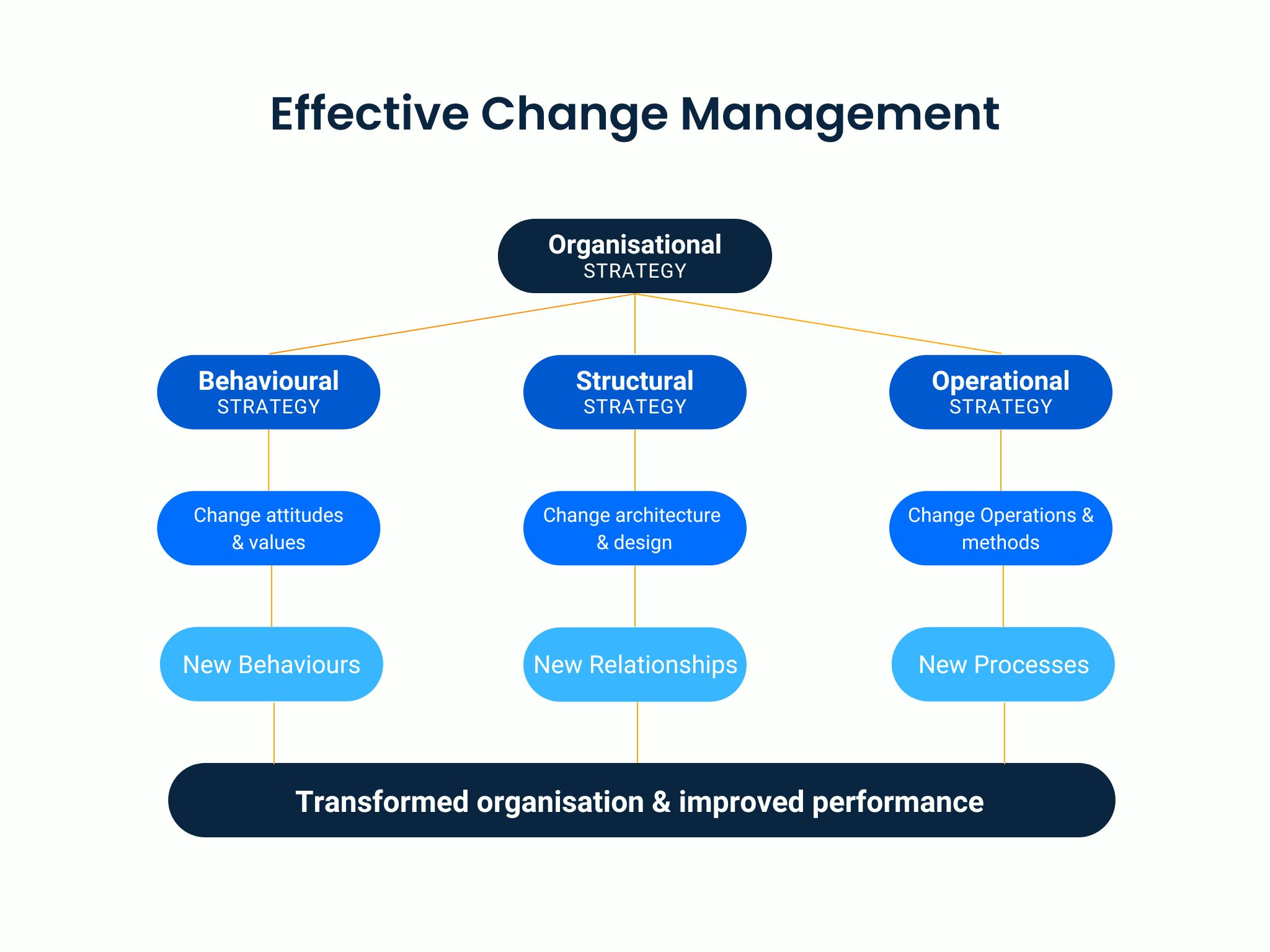Organisational change is frequently met with angst and negative emotions amongst teams & departments, often protracting the process and requiring more resources and time to bring about. Successful change management should focus on the impacts on the organisation structure as well as the well-being of the employees, always keeping productivity and improvement in mind.
The first and most important step is to use project management tools to correctly identify both the internal and external factors influencing the company, and using these to lay the foundation for a transformational organisational strategy, covering the three main sub-strategies for change; behavioural, structural and operational strategies:
Behavioural strategy focuses on changing the attitudes and values of the employees, through effective communication that provides reasons for change. Leadership and employee-motivation are key.
Structural strategy introduces the programme management office to the functional groups and how they are integrated.
Operational strategy and changes in business-methods must align to the critical success factors of the company as identified in various project management tools.

Unobtainable change goals – provide measurable and constant goals to the entire team (all levels of management and workforce) to ensure individual and company morale remains high and efficient working levels and tangible results motivate the team going forward.
Insufficient planning and omission of a programme office - A management-through-programmes tactic will deliver the best results for a transformational and organisational change.
Lack of team motivation and self-efficacy - low self-efficacy results in employees believing they are incapable of preforming tasks and achieving a certain goal as an individual or as a team, which then leads to low motivation.
Unattractive reward system – implementing a reward system that promotes employee and departmental cooperation, and the opportunity to celebrate individual and team successes has a vastly positive impact on the company culture.
Lack of leadership - strategic leadership is an integral tool in building organisational cohesion and achieving a competitive edge. It is no wonder then that strategic leadership is a key driver of strategic implementation (Louw & Venter 2013).
Unclear roles & responsibilities within the company - define roles and responsibilities that are clear, honest, and exact, and communicate this throughout the entire organisation from the top tiers of management, to functional managers, right through to employees.
An effective strategic change plan is based on a sound situational analysis. This describes the present organisational climate; it identifies internal and external factors that influence the organisation and provides a current view of all processes and employee well-being. The Pestel analysis tool is used to identify macro-environmental factors that impact the organisation. These factors are divided into six main categories of discussion namely; Political, Economic, Socio-cultural, Technology, Environmental and Legal (PESTEL).
Following a thorough analysis, the focus should be on the three main sub-strategies for change and various tools can be utilised to identify and change the strategies.
This focuses on the change of operations and methods; Robbins (2005) states change can be divided into two main categories namely:
First order change – small scale evolutionary and incremental change which influences the present situation without disrupting the general work cohesion of the company.
Second order change - transformational and strategic changes to the entire organisation which culminates in a new competitive advantage for the company.
Kotter (1996) described that, change is mainly influenced by the increasing demands of globalisation which effects all facets of business and human life. Rouse (2006) stated that change incorporates a framework for managing change in the organisation procedures like new processes, changes in organisational structures or organisational culture changes.

This focuses on the change of values and attitudes of the employees, and is positively impacted by Emotional Intelligence in Leadership:
Self-Awareness - the ability to not only analyse and comprehend your own emotions but identify your own strengths and weaknesses.This ability creates self-confidence, encourages appropriate evaluation of situations and how we come across to others in social situations.
Self-Management - controlling how a person expresses their own emotions and responds rationally to a situation rather than reacting emotionally. Setting definite goals, being honest with yourself,having a positive outlook on life and to change is necessary.
Social Awareness - empathising with group and social situations. Showing compassion towards others and contributing in various ways where the outcome not only influences yourself but others. The ability to convey your ideas and feelings in an appropriate manner.
Relationship Management - working well with others in a team situation, identifying change and the need to develop skills and knowledge to better a situation or relationship. Clearly portray ideas and communicate this to others.
This focuses on the change of organisational structure.
To control changes and facilitate all factors of organisational change, a programme team must be implemented. Murray-Webster et al. (2000) concluded that programme management team provides a cross functional framework through multiple levels of change factors that is encapsulated in the various milestones and deliverables.
Organisational change is driven by the symbiotic relationship between employees and internal structures within the company, and therefore a behavioural strategy must be set in place to motivate the individuals and groups within the company. Leadership must be set in place roles and responsibilities that are clear and communicated to all relevant parties. Together with behavioural strategy changes, a programme office must be created to implement and monitor change within the company. This will ensure that all facets of change are monitored, regulated, and corrected if need be. Continuous processes will ensure that change is constant and keeps the company ahead of the innovation curve.